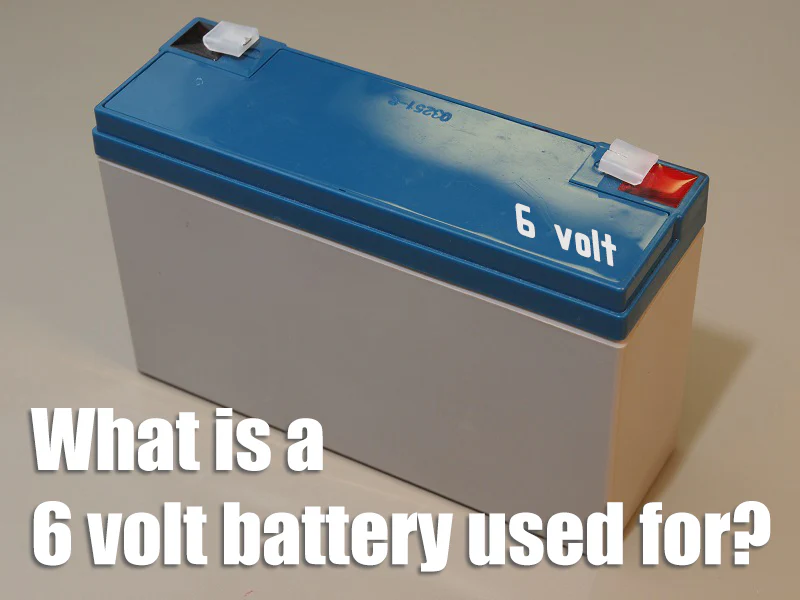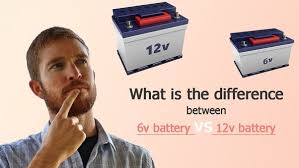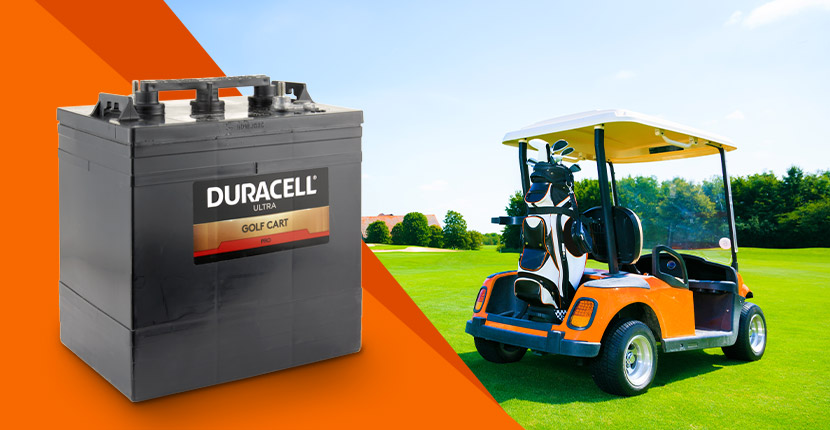
A 6 volt battery is commonly used in various applications that require lower voltage power supply. One example of its usage is in automotive applications, specifically vintage or classic cars. Many older vehicles, such as vintage motorcycles or classic cars, were designed to operate with a 6 volt electrical system. In these vehicles, a 6-volt battery is used to provide power for the ignition system, lights, and other electrical components.
6 volt batteries have various applications beyond vintage vehicles. They are commonly employed in toys, lighting devices, doorbells and alarms, electronic devices, and measurement instruments. In the realm of toys and models, 6 volt batteries power remote-controlled cars, dolls, and train models. For lighting purposes, they provide energy for camping lanterns, flashlights, emergency lights, and small solar powered lights. Traditional doorbells and alarm systems rely on 6 volt batteries to function effectively. Additionally, smaller electronic gadgets like remote controls, calculators, and wireless devices utilize these batteries. In the field of measurement instruments, 6 volt batteries drive the power supply for certain devices such as multi-purpose meters and portable measuring tools.
A 6 volt deep cycle battery is a type of lead-acid battery specifically designed for long, sustained periods of discharge followed by a full recharge. These batteries are engineered to provide a steady amount of current over an extended period, making them ideal for applications like golf carts, RVs, marine vessels, and off-grid renewable energy systems. Here's a detailed look at their characteristics.
Chemistry: Typically, these batteries use a lead-acid chemical composition, involving lead dioxide (PbO2) as the positive plate, sponge lead (Pb) as the negative plate, and a sulfuric acid (H2SO4) electrolyte solution.
Construction: Deep cycle batteries are built with thicker plates and a denser active material to withstand deep discharge cycles. Unlike their automotive counterparts, which are designed for short, high-current bursts to start an engine, deep cycle batteries can discharge up to 80% of their capacity repeatedly, without significant damage.
Capacity: Measured in ampere-hours (Ah), this indicates the battery's energy storage capability. A 6-volt deep cycle battery typically ranges from about 200Ah to over 400Ah, depending on the model and design.
Voltage: Nominal voltage is 6 volts, but the actual operating voltage may vary slightly during charge and discharge cycles.
Durability: Designed for repeated deep discharge and recharge cycles without significant degradation in capacity.
Versatility: Suitable for a variety of applications that require a steady and reliable power supply over extended periods.
Maintenance: Flooded lead-acid varieties require regular checking and topping up of electrolyte levels, whereas sealed versions like AGM (Absorbed Glass Mat) and Gel batteries offer maintenance-free operation.
Weight and size: These batteries are heavy and bulky due to their lead content and robust construction, which can be a consideration in mobile applications.
Cost: Generally, they are more expensive upfront than standard automotive batteries due to their specialized design and longer lifespan.
Charging: Proper charging is crucial for maximizing lifespan and performance. Overcharging or undercharging can significantly impact battery health.
Some well-regarded brands and models include the Trojan T-105, known for its reliability and longevity in various deep cycle applications, and the Crown CR-235, which offers excellent durability and performance.
In summary, 6-volt deep cycle batteries are a critical component for systems requiring reliable, long-term energy delivery. Their design and construction cater to applications where a consistent power supply is necessary over extended periods, balancing the need for durability, capacity, and performance.

The primary difference between 6-volt and 12-volt batteries lies in their voltage and application, but there are also nuances in capacity, size, and how they are used in various setups. Here's a detailed comparison.
Voltage: The most apparent difference is the nominal voltage; a 6-volt battery provides 6 volts, while a 12-volt battery offers 12 volts. Voltage is a measure of electrical potential, determining how much electrical energy can be delivered at a given time.
Energy storage: While voltage does not directly dictate the total energy storage, which is measured in ampere-hours (Ah), it affects how that energy is delivered. For a given capacity (Ah), a 12-volt battery can deliver more power (watts) at a time than a 6-volt battery because power is the product of voltage and current (P=V*I).
Size and weight: Generally, 6-volt batteries might be slightly smaller and lighter than 12-volt batteries, but this can vary greatly depending on the specific capacity (Ah) and technology (e.g., lead-acid vs. lithium-ion) of the batteries compared. However, when used in series to achieve the same total voltage, a setup using 6-volt batteries might end up larger and heavier than using a single 12-volt battery due to the additional materials and casing.
6 volt batteries: Often used in series to build higher voltage systems (e.g., four 6-volt batteries to create a 24-volt system). Common in golf carts, small recreational vehicles, and some renewable energy storage applications, where multiple batteries are used to achieve desired capacity and voltage.
12 volt batteries: The standard for most automotive applications, as well as many boats, RVs, and motorcycles. They are also widely used in portable power supplies, backup power systems, and smaller renewable energy setups.
Series configuration: Connecting batteries in series increases the system's overall voltage while keeping the capacity (Ah) the same. Using 6-volt batteries in series allows for flexible configurations to achieve various voltages (e.g., 12, 24, 36 volts).
Parallel configuration: Connecting batteries in parallel increases the system's overall capacity (Ah) while keeping the voltage the same. This is often used with 12-volt batteries to increase the available power without changing the system's voltage.
Deep cycle performance: Both 6-volt and 12-volt batteries can be designed for deep cycle applications. However, 6-volt batteries, particularly those in the lead-acid category, are often designed with thicker plates, which can offer better deep discharge recovery and longer life in applications requiring deep, regular discharging.
Maintenance and durability: Maintenance needs (e.g., water topping in lead-acid batteries) and durability can vary more by the technology (lead-acid vs. lithium-ion vs. AGM) and quality of construction rather than the voltage itself.
In summary, the choice between 6-volt and 12-volt batteries should be based on the specific requirements of the application, including the desired voltage, capacity, size, weight constraints, and whether the system design allows for series or parallel configurations.

6 volt golf cart batteries are specifically designed to power golf carts, which are widely used for transportation on golf courses and in other recreational environments. These batteries play a crucial role in providing the necessary energy to propel and operate golf carts efficiently. Golf cart batteries are typically deep cycle batteries, meaning they are designed to deliver a steady and consistent flow of power over an extended period. Unlike starting batteries that provide short bursts of high energy, deep cycle batteries are engineered to provide sustained power for longer durations. The 6 volt configuration is commonly used in golf carts due to the desired balance between power output and battery size. By connecting multiple 6 volt batteries in series, a higher overall voltage can be achieved, typically 36 or 48 volts, which is necessary to drive the electric motor of the golf cart. These batteries are built to withstand the demands of golf cart usage, which involves frequent charging and discharging cycles. They are constructed with thick plates and robust internal components to handle the deep cycling requirements. Additionally, golf cart batteries are designed to be maintenance-free, requiring minimal upkeep and providing convenience for the users.
When it comes to choosing the best golf cart batteries, several options stand out due to their reliability, performance, and longevity. Here is a detailed overview of some of the top choices available in the market
Type: Flooded Lead-acid battery
Voltage: 6V
Capacity: 225 Ah
Description: Trojan batteries are renowned for their durability and long lifespan. The T-105 is a 6V deep-cycle battery that provides consistent power and can withstand numerous discharge and recharge cycles. It is a popular choice for golf carts due to its proven performance and reliability over the years.
Type: Flooded Lead-acid battery
Voltage: 6V
Capacity: 232 Ah
Description: US Battery is another reputable brand in the golf cart industry. The US2200 XC2 offers a slightly higher capacity than the Trojan T-105, making it an excellent choice for those looking for extended run times. This battery is designed to deliver high performance and long service life, with advanced technology to enhance charge efficiency.
Type: Flooded Lead-acid battery
Voltage: 6V
Capacity: 235 Ah
Description: Crown batteries are known for their robust construction and reliable performance. The CR-235 is a 6V battery that provides a high capacity, ensuring longer intervals between charges. Its heavy-duty design makes it a solid choice for users who require a battery that can handle frequent use and demanding conditions.
Type: Flooded Lead-acid battery
Voltage: 8V
Capacity: 170 Ah
Description: For golf carts that require an 8V battery, the Trojan T-875 is an excellent option. It offers the same reliable performance as other Trojan models but in an 8V package. This battery is known for its long lifespan and ability to deliver steady power throughout its discharge cycle.
Type: Lithium-lon battery
Voltage: Various (commonly 12V, 36V, 48V)
Capacity: Varies by model
Description: Lithium Iron Phosphate (LiFePO4) batteries are becoming increasingly popular for golf carts due to their long lifespan, lightweight design, and superior performance. Brands like Battle Born and RELiON offer lithium batteries that provide significant advantages over traditional lead-acid batteries, including faster charging times, deeper discharge capabilities, and minimal maintenance requirements. While they are more expensive upfront, their longevity and efficiency can make them a cost-effective choice in the long run.
Type: Flooded Lead-acid battery
Voltage: 6V
Capacity: 230 Ah
Description: The Deka GC15 is another reliable flooded lead-acid battery option. It offers a high capacity and is designed for deep-cycle applications, making it suitable for golf carts that need dependable power for extended periods. Deka batteries are known for their quality and consistent performance.
When selecting a golf cart battery, it's essential to consider factors such as voltage requirements, capacity, maintenance needs, and overall cost. Flooded lead-acid batteries like the Trojan T-105 and US Battery US2200 XC2 are traditional choices with a proven track record, while lithium-ion batteries offer modern advantages in terms of lifespan and efficiency. Each type has its own set of benefits, so choosing the best battery will depend on your specific needs and preferences.




The lab focuses on solid-state battery research to overcome traditional lithium batteries' safety and energy density issues, supporting environmental sustainability. It develops innovative solid-state electrolytes, refines electrode materials, and investigates ion transfer and interface stability to revolutionize battery technology.

The electric vehicle battery industry is rapidly developing, focusing on technological innovation, market competition, and sustainability. Research hotspots include solid-state batteries, new types of electrolytes, BMS optimization, and recycling technologies. The environmental adaptability, safety, and economic viability of batteries are key research areas, and the industry is expected to undergo more innovation and transformation.

Specializing in battery preparation technology research, the focus is on overcoming existing energy storage challenges by innovating in electrode materials, battery chemistry, and manufacturing processes to improve performance, safety, and reduce costs. Sustainability and recycling technologies for batteries are also emphasized to mitigate environmental impacts and foster the growth of green energy.